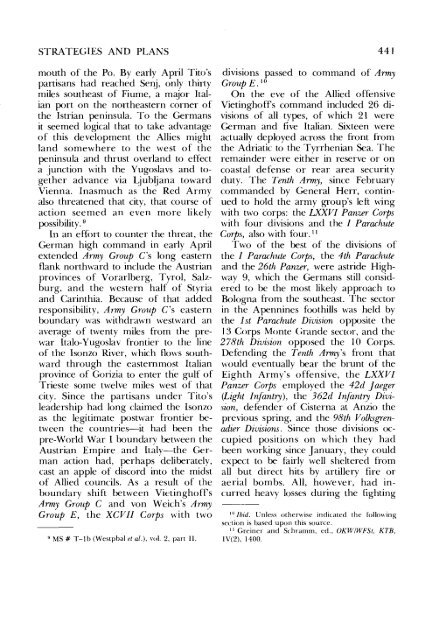Cassino to the Alps - US Army Center Of Military History
Cassino to the Alps - US Army Center Of Military History
Cassino to the Alps - US Army Center Of Military History
You also want an ePaper? Increase the reach of your titles
YUMPU automatically turns print PDFs into web optimized ePapers that Google loves.
STRATEGIES AND PLANS<br />
mouth of <strong>the</strong> Po. By early April Ti<strong>to</strong>'s<br />
partisans had reached Senj, only thirty<br />
miles sou<strong>the</strong>ast of Fiume, a major Italian<br />
port on <strong>the</strong> nor<strong>the</strong>astern corner of<br />
<strong>the</strong> Istrian peninsula. To <strong>the</strong> Germans<br />
it seemed logical that <strong>to</strong> take advantage<br />
of this development <strong>the</strong> Allies might<br />
land somewhere <strong>to</strong> <strong>the</strong> west of <strong>the</strong><br />
peninsula and thrust overland <strong>to</strong> effect<br />
a junction with <strong>the</strong> Yugoslavs and <strong>to</strong>ge<strong>the</strong>r<br />
advance via Ljubljana <strong>to</strong>ward<br />
Vienna. Inasmuch as <strong>the</strong> Red <strong>Army</strong><br />
also threatened that city, that course of<br />
action seemed an even more likely<br />
possibility. 9<br />
In an effort <strong>to</strong> counter <strong>the</strong> threat, <strong>the</strong><br />
German high command in early April<br />
extended <strong>Army</strong> Group C's long eastern<br />
flank northward <strong>to</strong> include <strong>the</strong> Austrian<br />
provinces of Vorarlberg, Tyrol, Salzburg,<br />
and <strong>the</strong> western half of Styria<br />
and Carinthia. Because of that added<br />
responsibility, <strong>Army</strong> Group C's eastern<br />
boundary was withdrawn westward an<br />
average of twenty miles from <strong>the</strong> prewar<br />
!talo-Yugoslav frontier <strong>to</strong> <strong>the</strong> line<br />
of <strong>the</strong> Isonzo River, which flows southward<br />
through <strong>the</strong> easternmost Italian<br />
province of Gorizia <strong>to</strong> enter <strong>the</strong> gulf of<br />
Trieste some twelve miles west of that<br />
city. Since <strong>the</strong> partisans under Ti<strong>to</strong>'s<br />
leadership had long claimed <strong>the</strong> Isonzo<br />
as <strong>the</strong> legitimate postwar frontier between<br />
<strong>the</strong> countries-it had been <strong>the</strong><br />
pre-World War I boundary between <strong>the</strong><br />
Austrian Empire and Italy-<strong>the</strong> German<br />
action had, perhaps deliberately,<br />
cast an apple of discord in<strong>to</strong> <strong>the</strong> midst<br />
of Allied councils. As a result of <strong>the</strong><br />
boundary shift between Vietinghoffs<br />
<strong>Army</strong> Group C and von Weich's <strong>Army</strong><br />
Group E, <strong>the</strong> XCVII Corps with two<br />
9 MS # T-lb (Westpbal et at.). vol. 2, part II.<br />
441<br />
divisions passed <strong>to</strong> command of <strong>Army</strong><br />
Group E.1O<br />
On <strong>the</strong> eve of <strong>the</strong> Allied offensive<br />
Vietinghoffs command included 26 divisions<br />
of all types, of which 21 were<br />
German and five Italian. Sixteen were<br />
actually deployed across <strong>the</strong> front from<br />
<strong>the</strong> Adriatic <strong>to</strong> <strong>the</strong> Tyrrhenian Sea. The<br />
remainder were ei<strong>the</strong>r in reserve or on<br />
coastal defense or rear area security<br />
duty. The Tenth <strong>Army</strong>, since February<br />
commanded by General Herr, continued<br />
<strong>to</strong> hold <strong>the</strong> army group's left wing<br />
with two corps: <strong>the</strong> LXXVI Panzer Corps<br />
with four divisions and <strong>the</strong> I Parachute<br />
Corps, also with four. 11<br />
Two of <strong>the</strong> best of <strong>the</strong> divisions of<br />
<strong>the</strong> I Parachute Corps, <strong>the</strong> 4th Parachute<br />
and <strong>the</strong> 26th Panzer, were astride Highway<br />
9, which <strong>the</strong> Germans still considered<br />
<strong>to</strong> be <strong>the</strong> most likely approach <strong>to</strong><br />
Bologna from <strong>the</strong> sou<strong>the</strong>ast. The sec<strong>to</strong>r<br />
in <strong>the</strong> A pennines foothills was held by<br />
<strong>the</strong> 1 st Parachute Division opposite <strong>the</strong><br />
13 Corps Monte Grande sec<strong>to</strong>r, and <strong>the</strong><br />
278th Division opposed <strong>the</strong> 10 Corps.<br />
Defending <strong>the</strong> Tenth <strong>Army</strong>'s front that<br />
would eventually bear <strong>the</strong> brunt of <strong>the</strong><br />
Eighth <strong>Army</strong>'s offensive, <strong>the</strong> LXXVI<br />
Panzer Corps employed <strong>the</strong> 42d Jaeger<br />
(Light Infantry), <strong>the</strong> 362d Infantry Division,<br />
defender of Cisterna at Anzio <strong>the</strong><br />
previous spring, and <strong>the</strong> 98th Volksgrenadier<br />
Divisions. Since those divisions occupied<br />
positions on which <strong>the</strong>y had<br />
been working since January, <strong>the</strong>y could<br />
expect <strong>to</strong> be fairly well sheltered from<br />
all but direct hits by artillery fire or<br />
aerial bombs. All, however, had incurred<br />
heavy losses during <strong>the</strong> fighting<br />
10 Ibid. Unless o<strong>the</strong>rwise indicated <strong>the</strong> f()llowing<br />
section is based upon this source.<br />
II Greiner and Schramm, ed., OKW/WFSt, KTB,<br />
IV(2), 1400.
















